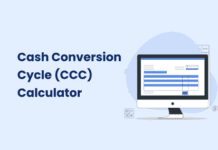Navigating the financial health of a business involves more than just tracking profits and losses. Understanding how cash moves within an organization is crucial for effective financial management. In this blog, discover what is a cash flow statement, understand its purpose, and learn how to prepare one step-by-step, complete with formulas and examples.
What is a Cash Flow Statement?
The cash flow statement is a financial document that gives a snapshot of the company’s cash flow, that is cash and cash equivalents flowing in and out of a company. It works hand in hand with the balance sheet and income statement, providing a comprehensive view of the financial health of a business.
The cash flow statement is crucial for predicting cash needs and planning for the short term. It provides valuable insights for management decisions, helping regulate business operations based on informed judgments. Companies always aim for a positive cash flow to ensure financial health.
Purpose of a cash flow statement
The cash flow statement is an essential financial document that gives a detailed picture of how a company handles its cash and ensures liquidity. Unlike the income statement and balance sheet, it concentrates on tracking the actual cash movements during a specific period, usually a fiscal year.
The main goal of this statement is to provide insights into how a company generates and utilizes its cash resources. Visualizing this data will allow you to effectively manage your cash flow.
Components of a Cash Flow Statement
Operating Activities
These involve cash movements tied to a company’s primary operations, such as cash from customer sales and payments to suppliers.
Examples:
- Cash from selling goods or services.
- Cash paid to suppliers for inventory or raw materials.
- Cash disbursed as wages or salaries.
- Cash transactions for interest on loans or received as interest income.
Impact on Cash Flow:
A positive operating cash flow indicates where core operations generate more cash than expended. On the other hand, a negative operating cash flow may signal issues like declining sales or inefficient working capital management.
Investing Activities
These encompass cash flows associated with long-term assets and investments, including property, plant, and equipment, as well as stocks or bonds.
Examples:
- Cash spent on new equipment or machinery.
- Cash received from selling property or investments.
- Cash used for acquiring another company.
- Cash received as a result of repaying debts given to others.
Impact on Cash Flow:
Investing activities can significantly affect a company’s cash position. Purchasing assets reduces cash while selling them boosts cash reserves.
Financing Activities
These pertain to obtaining or repaying funds for operations and growth, involving cash from issuing or borrowing funds and payments for debt repayment or dividend distribution.
Examples:
- Cash from issuing new shares of stock.
- Cash from borrowing through loans or issuing bonds.
- Cash used for loan or bond repayments.
- Cash paid as dividends to shareholders.
Impact on Cash Flow:
Financing activities have a substantial impact on a company’s cash position. Inflows provide capital, while outflows decrease cash. Analyzing these activities helps assess reliance on external funding and the commitment to shareholders.
Methods of Cash Flow Statement
There are two main approaches to creating a cash flow statement: the direct method and the indirect method.
Direct Method
With the direct method, the statement directly outlines cash inflows and outflows related to operating activities. This includes specifics like cash received from customers and cash paid to suppliers. While the direct method offers a clearer view, it demands detailed transactional data, making it more time-intensive.
Indirect Method
The indirect method starts with net income from the income statement and adjusts it to shift from an accrual basis to a cash basis. It includes adding or subtracting non-cash items, such as depreciation, changes in inventory, and accounts receivable, to determine the cash flow from operating activities. The indirect method is more commonly used because it’s less complex and relies on readily available financial statements.
Direct vs. Indirect Method
Regardless of the method chosen, the net cash flow remains the same. The difference lies in how the information is presented. Here’s a comparative example illustrating both approaches.
Preparing Cash Flow Statements: Step-by-Step Guide with Formula
Here’s a step-by-step guide to help you crunch the numbers:
Step 1: Determine operating cash flow
To calculate operating cash flow, add your net income and non-cash expenses, then deduct the change in working capital.
| Operating Cash Flow = Net Income + Non-Cash Expenses – Change in Working Capital |
For example: If Company XYZ has
Net Income = $100,000
Non-Cash Expenses = $50,000
Change in Working Capital = $25,000
Then, Operating Cash Flow = $100,000 + $50,000 – $25,000 = $125,000
Step 2: Assess investing cash flow
To calculate cash flow from investing activities, add the cash generated from selling assets and then deduct capital expenditures.
| Investing Cash Flow = Cash from Asset Sales – Capital Expenditures |
For example: If Company XYZ has
Cash from Asset Sales = $40,000
Capital Expenditures = $10,000
Then, Investing Cash Flow = $40,000 – $10,000 = $30,000
Step 3: Examine financing cash flow
To calculate cash flow from financing activities, add dividends paid and repurchase debt and equity, then deduct cash inflows from issuing equity or debt.
| Financing Cash Flow = Cash Inflows from Issuing Equity or Debt – (Dividends Paid + Repurchase of Debt and Equity) |
For example: If Company XYZ has
Cash Inflows from Issuing Equity or Debt = $120,000
Dividends Paid = $20,000
Repurchase of Debt and Equity = $20,000
Then, Financing Cash Flow = $120,000 – ($20,000 + $20,000) = $80,000
Step 4: Calculate Net Cash Flow
This final calculation by adding operating cash flow, investing cash flow, and financing cash flow gives you the overall cash flow for a specific period.
| Net Cash Flow = Operating Cash Flow + Investing Cash Flow + Financing Cash Flow |
Thus, for XYZ Company, Net Cash Flow = $125,000 + $30,000 + $80,000 = $235,000
For a better understanding, take a look at the cash flow statement example below.
To have better visibility over weekly, monthly, and quarterly cash flow statements, utilize a ready-to-use cash flow calculator or leverage AI-powered solutions.
Role of Cash Flow Statements in the Big Picture
A cash flow statement is not a standalone document but an essential piece in the puzzle of financial analysis. It complements other financial reports, such as the income statement and balance sheet, to provide a holistic view of a company’s financial performance. Mastering the complexities of cash flow statements empowers both businesses and investors to make well-informed decisions, laying the foundation for a resilient and sustainable financial future.









![Why AI Sales Calls Are Making Good Sales Reps Even Better [2025 Guide] ai sales calls](https://cdn-kmjmp.nitrocdn.com/YvtqmrsiHUxqerlSiZgbfzqqTARWTElr/assets/images/optimized/rev-834053b/blog.peakflo.co/wp-content/uploads/2025/09/65168cf6-3001-4733-8cbc-12d5684cf449-218x150.webp)

































